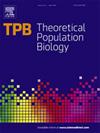连杆不平衡的一种均匀测量。
IF 1.3
4区 生物学
Q4 ECOLOGY
引用次数: 0
摘要
连锁不平衡(LD),等位基因在两个位点的关联,有多种定义。由于LD测量依赖于等位基因频率,因此很难比较具有不同等位基因频率的种群或位点之间的LD值。在这里,我考虑了常用的LD测量r2的几何解释,它表明了一种频率无关的修改,即相等的进化力在不同频率上导致相同的效果。这个新度量是一个非常简单的表达式,在其他地方被称为哈曼系数和G一致指数;它是简单匹配系数的线性变换。通过与D和r2的比较,探讨了这个量的性质,并讨论了它的解释和优缺点。本文章由计算机程序翻译,如有差异,请以英文原文为准。
An equal-tempered measure of linkage disequilibrium
Linkage disequilibrium (LD), the association of alleles at two loci, is defined in multiple ways. Because LD measures depend on allele frequencies, it is difficult to compare LD values between populations or loci with different allele frequencies. Here, I consider a geometric interpretation of a commonly used LD measure which suggests a modification that is frequency-independent in the sense that equal evolutionary forces lead to the same effect at different frequencies. This new measure is a very simple expression that is known elsewhere as the Hamann coefficient and the G index of agreement; it is a linear transformation of the simple matching coefficient. I explore properties of this quantity in comparison with and , and discuss its interpretation, advantages and disadvantages.
求助全文
通过发布文献求助,成功后即可免费获取论文全文。
去求助
来源期刊

Theoretical Population Biology
生物-进化生物学
CiteScore
2.50
自引率
14.30%
发文量
43
审稿时长
6-12 weeks
期刊介绍:
An interdisciplinary journal, Theoretical Population Biology presents articles on theoretical aspects of the biology of populations, particularly in the areas of demography, ecology, epidemiology, evolution, and genetics. Emphasis is on the development of mathematical theory and models that enhance the understanding of biological phenomena.
Articles highlight the motivation and significance of the work for advancing progress in biology, relying on a substantial mathematical effort to obtain biological insight. The journal also presents empirical results and computational and statistical methods directly impinging on theoretical problems in population biology.
 求助内容:
求助内容: 应助结果提醒方式:
应助结果提醒方式:


